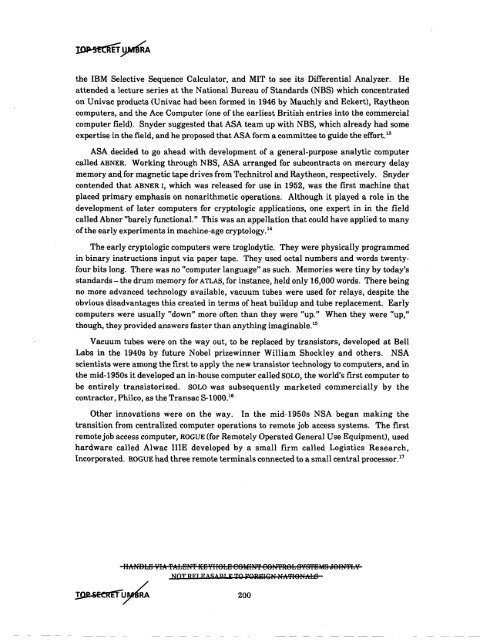American Cryptology during the Cold War - The Black Vault
American Cryptology during the Cold War - The Black Vault
American Cryptology during the Cold War - The Black Vault
Create successful ePaper yourself
Turn your PDF publications into a flip-book with our unique Google optimized e-Paper software.
<strong>the</strong> IBM Selective Sequence Calculator, and MIT to see its Differential Analyzer. He<br />
attended a lecture series at <strong>the</strong> National Bureau of Standards (NBS) which concentrated<br />
on Univac products (Univac had been formed in 1946 by Mauchly and Eckert), Ray<strong>the</strong>on<br />
computers, and <strong>the</strong> Ace Computer (one of <strong>the</strong> earliest British entries into <strong>the</strong> commercial<br />
computer field). Snyder suggested that ASA team up with NBS, which already had some<br />
expertise in <strong>the</strong> field, and he proposed that ASA form a committee to guide <strong>the</strong> effort. 13<br />
ASA decided to go ahead with development of a general-purpose analytic computer<br />
called ABNER. Working through NBS, ASA arranged for subcontracts on mercury delay<br />
memory anq for magnetic tape drives from Technitrol and Ray<strong>the</strong>on, respectively. Snyder<br />
contended that ABNER I, which was released for use in 1952, was <strong>the</strong> first machine that<br />
placed primary emphasis on nonarithmetic operations. Although it played a role in <strong>the</strong><br />
development of later computers for cryptologic applications, one expert in in <strong>the</strong> field<br />
called Abner "barely functionaL" This was an appellation that could have applied to many<br />
of<strong>the</strong> early experiments in machine-age cryptology.14<br />
<strong>The</strong> early cryptologic computers were troglodytic. <strong>The</strong>y were physically programmed<br />
in binary instructions input via paper tape. <strong>The</strong>y used octal numbers and words twentyfour<br />
bits long. <strong>The</strong>re was no "computer language" as such. Memories were tiny by today's<br />
standards - <strong>the</strong> drum memory for ATLAS, for instance, held only 16,000 words. <strong>The</strong>re being<br />
no more advanced technology available, vacuum tubes were used for relays, despite <strong>the</strong><br />
obvious disadvantages this created in terms of heat buildup and tube replacement. Early<br />
computers were usually "down" more often than <strong>the</strong>y were "up." When <strong>the</strong>y were "up,"<br />
though, <strong>the</strong>y provided answers faster than anything imaginable.15<br />
Vacuum tubes were on <strong>the</strong> way out, to be replaced by transistors, developed at Bell<br />
Labs in <strong>the</strong> 1940s by future Nobel prizewinner William Shockley and o<strong>the</strong>rs. NSA<br />
scientists were among <strong>the</strong> first to apply <strong>the</strong> new transistor technology to computers, and in<br />
<strong>the</strong> mid-1950s it developed an in-house computer called SOLO, <strong>the</strong> world's first computer to<br />
be entirely transistorized. SOLO was subsequently marketed commercially by <strong>the</strong><br />
contractor, Philco, as <strong>the</strong> Transac S-1000. 16<br />
O<strong>the</strong>r innovations were on <strong>the</strong> way. In <strong>the</strong> mid-1950s NSA began making <strong>the</strong><br />
transition from centralized computer operations to remote job access systems. <strong>The</strong> first<br />
remotejob access computer, ROGUE (for Remotely Operated General Use Equipment), used<br />
hardware called Alwac HIE developed by a small firm called Logistics Research,<br />
Incorporated. ROGUE had three remote terminalsconnected to a small central processor. 17<br />
IIAPfBbEi VIA 'fAbSU'f KS YIISbS eSMIN'f eON'FROb SYS'FEiMS dOIN'FbY<br />
NOT REI EASAijI F TO i'OREIQl'i ~TA'fI8U-A:bS<br />
200
















